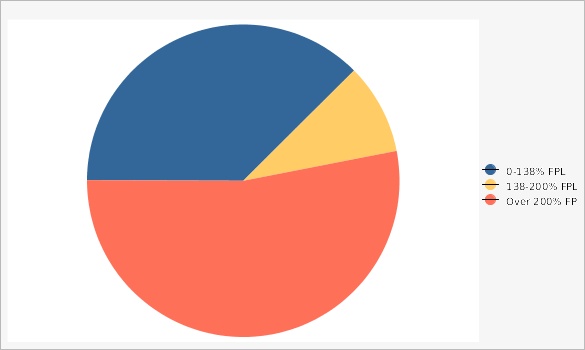Complete Health Indicator Report of Uninsured Children
Definition
The percentage of uninsured Utah children who are income-eligible for the Medicaid (0-138% FPL) or CHIP (138-200% FPL) programs. Eligibility determination requires a review of circumstances in addition to income.Numerator
The number of children in surveyed households in each category (Utah Behavioral Risk Factor Surveillance System).Denominator
The total number of children in surveyed households for whom valid data were reported (i.e., the missing values were removed from the denominator).Data Interpretation Issues
Data for this report were calculated using only age and income eligibility requirements. However, there are additional requirements that must be met in order for children aged 0 to 18 years to qualify for either CHIP (Children's Health Insurance Plan) or Medicaid. Specifically, Medicaid requires that children aged 0 to 5 years must live in homes with incomes at or below 133% of poverty (plus a new 5% disregard effective January 2014, making the effective income level 138% of poverty). Children aged 6 to 18 years must live at or below 133% of poverty. Additionally, children can still qualify for Medicaid even if they have some other kind of insurance. For CHIP eligibility, all children aged 0 to 18 years must live in homes with incomes below 200% of poverty (plus a new 5% disregard effective January 2014, making the effective income level 205% of poverty) and cannot be eligible for Medicaid and cannot be enrolled on any another type of insurance plan. The Utah Behavioral Risk Factor Surveillance System (BRFSS) does not have the capacity to measure Medicaid and CHIP eligibility in a way that accounts for all requirements for the two programs. Therefore, data for this report are based only on income and whether or not children had insurance coverage. Beginning in 2011, BRFSS data include both landline and cell phone respondent data along with a new weighting methodology called iterative proportional fitting, or raking. This methodology utilizes additional demographic information in the weighting procedure. Graphs within this Indicator Report are based on the new methodology. More details about these changes can be found at: [https://ibis.health.utah.gov/pdf/opha/resource/brfss/RakingImpact2011.pdf]. BRFSS data were weighted to reflect the Utah population distribution by age, sex, geographic area, race, education, marital status, and homeownership. Health insurance was defined as including private coverage, Medicaid, Medicare, and other government programs.Why Is This Important?
Children who are not insured by private or employer-provided plans have an opportunity to be covered by Medicaid or the Children's Health Insurance Program (CHIP) if they are age 0-18, a U.S. citizen or legal resident, and live in households with incomes below 200% of poverty. This element is very important given the relationship between having insurance and accessing health care.Healthy People Objective AHS-1.1:
Increase the proportion of persons with medical insuranceU.S. Target: 100 percent
Other Objectives
Related to Healthy People 2030 Objective AHS 1.1: Increase the proportion of persons with medical insurance.[[br]] '''U.S. Target:''' 100 percentHow Are We Doing?
In 2019, approximately 4.8% of Utah children aged 0 to 18 years (including 18-year-olds) had no health insurance coverage.How Do We Compare With the U.S.?
National estimates of the lack of health insurance coverage for children aged 0-18 are lower (5.7%) than for Utah (8.3%) based on the 2019 ACS (American Community Survey). Please note that the methods used to calculate the uninsured rate between the ACS and the BRFSS are different. This report uses the BRFSS as its data source.Available Services
MEDICAID: In the Salt Lake City area, call (801) 538-6155 In Utah, Idaho, Wyoming, Colorado, New Mexico, Arizona, and Nevada, call toll-free (800) 662-9651[[br]] From other states, call (801) 538-6155[[br]] Medicaid Customer Service staff are available to take inquiries. CHIP: Children's Health Insurance Program (for children 0-18)[[br]] (888) 222-2542 or visit the CHIP website at [http://chip.health.utah.gov/]Related Indicators
Relevant Population Characteristics
Eligibility for Medicaid and CHIP is based largely on family income, as a percentage of the federal poverty level. However, other factors are involved in determination of program eligibility, such as disability (Medicaid), or recent private plan coverage (CHIP). Children born outside the U.S. who have not lived in the U.S. for at least five years are not eligible for Medicaid or CHIP, regardless of their family's income.Related Relevant Population Characteristics Indicators:
Health Care System Factors
Only children with no other health plan coverage are eligible to receive CHIP services.Related Health Care System Factors Indicators:
Risk Factors
Income is used as a primary factor in eligibility requirements for both Medicaid and CHIP.Related Risk Factors Indicators:
Graphical Data Views
Uninsured Children Aged 0-18 by Federal Poverty Levels, Utah, 2020

An estimated 4.8% of Utah children aged 0-18 lacked health insurance coverage in 2019. The percentages in this figure represent the estimated percentage of all uninsured Utah children aged 0-18 in each category. 138% and 200% of the federal poverty level are the maximums for Medicaid and CHIP.
| Income Eligibility | Percentage of Children | Note | ||||
|---|---|---|---|---|---|---|
Record Count: 3 | ||||||
| 0-138% FPL | 37.5% | Income Eligible for Medicaid | ||||
| 138-200% FPL | 9.4% | Income Eligible for CHIP | ||||
| Over 200% FPL | 53.1% | Household Over 200% FPL | ||||
Data Notes
For more historical estimates of the uninsured in Utah, please see: [https://ibis.health.utah.gov/pdf/opha/publication/ins/2017_InsuranceAnalysis.pdf].Data Source
Utah Data: Behavioral Risk Factor Surveillance System, Office of Public Health Assessment, Utah Department of HealthMore Resources and Links
Evidence-based community health improvement ideas and interventions may be found at the following sites:- Centers for Disease Control and Prevention (CDC) WONDER Database, a system for disseminating public health data and information.
- United States Census Bureau data dashboard.
- Utah healthy Places Index, evidence-based and peer-reviewed tool, supports efforts to prioritize equitable community investments, develop critical programs and policies across the state, and much more.
- County Health Rankings
- Kaiser Family Foundation's StateHealthFacts.org
- Medical literature can be queried at PubMed library.
Page Content Updated On 10/28/2021,
Published on 12/02/2021
